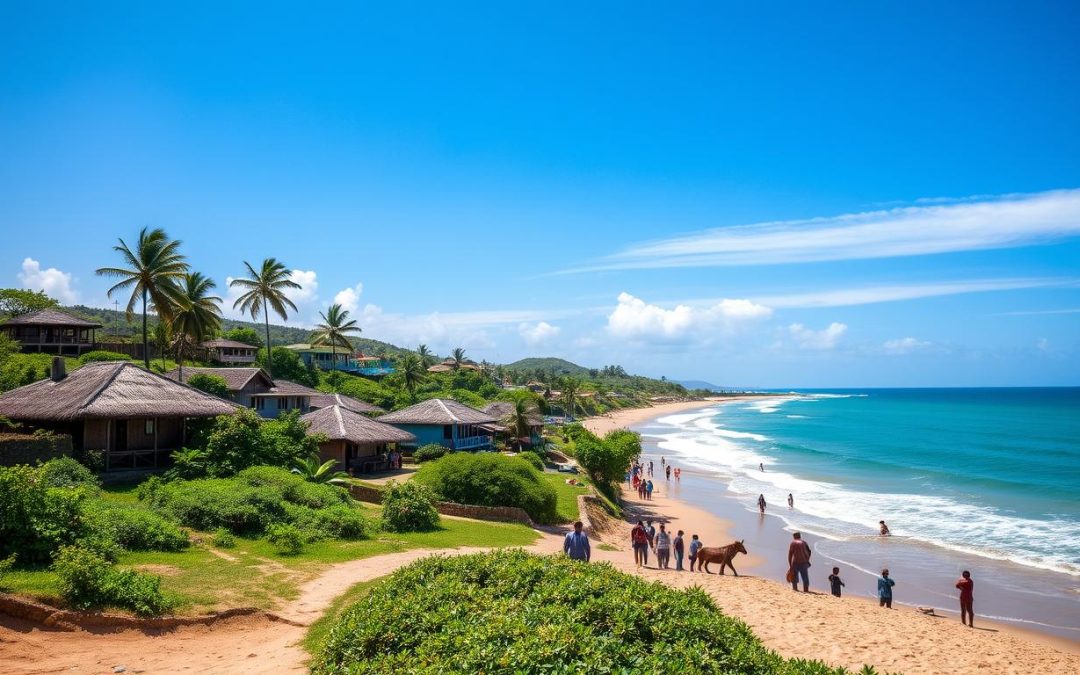Have you ever wondered how a small island nation in the Indian Ocean weaves together multiple languages into its cultural fabric? The Comoros presents a fascinating linguistic tapestry that challenges traditional language boundaries.
In the Comoros, language is more than communication—it’s a living reflection of historical journeys and cultural interactions. The 2001 constitution recognizes three official languages: Comorian, French, and Arabic. Each represents a unique layer of the nation’s complex identity.
With approximately 96% of the population speaking Comorian, this language dominates daily life. French serves governmental and commercial spheres, while Arabic maintains its religious and cultural significance. The linguistic diversity of Comoros tells a story of migration, colonization, and resilience.
Key Takeaways
- Comorian is spoken by 96.9% of the population
- Three official languages coexist in Comoros
- French influences remain strong from colonial period
- Arabic plays a significant cultural role
- Language reflects complex historical interactions
Linguistic Diversity in the Comoros Archipelago
The Comoros archipelago is a unique example of linguistic diversity. Here, languages blend together like the waves around the volcanic islands. Exploring the archipelago’s languages shows a rich cultural history.
Language development in the Comoros has been influenced by many historical events. About 700,000 native Comorian speakers make up 97% of the population. This shows a deep linguistic heritage.
Historical Influences on Language Development
The archipelago’s language diversity comes from complex historical interactions. Key factors include:
- Maritime trade routes connecting Africa, Arabia, and Indian Ocean cultures
- Colonial periods under Malagasy and French rule
- Religious and cultural exchanges with Arab traders
Role of Maritime Trade Routes
Maritime trade has made the Comoros a crossroads of languages. Traders from various regions brought languages that blended into local speech.
“Language is the roadmap of a culture. It tells you where its people come from and where they are going.” – Rita Mae Brown
Colonial Impact on Language Distribution
Colonial rule changed how languages were used. French is an official language but spoken by less than 1% of people. Arabic is a second language for most, mainly used in religious settings.
The linguistic diversity of the Comoros archipelago shows a complex history. It reflects cultural interactions, trade, and colonial experiences that still influence communication today.
Comorian Language: The Nation’s Mother Tongue
The Comorian language, known as Shikomoro, is at the heart of the Comoros’ identity. It is spoken by over 96.9% of the people. This Bantu language connects communities across the islands.
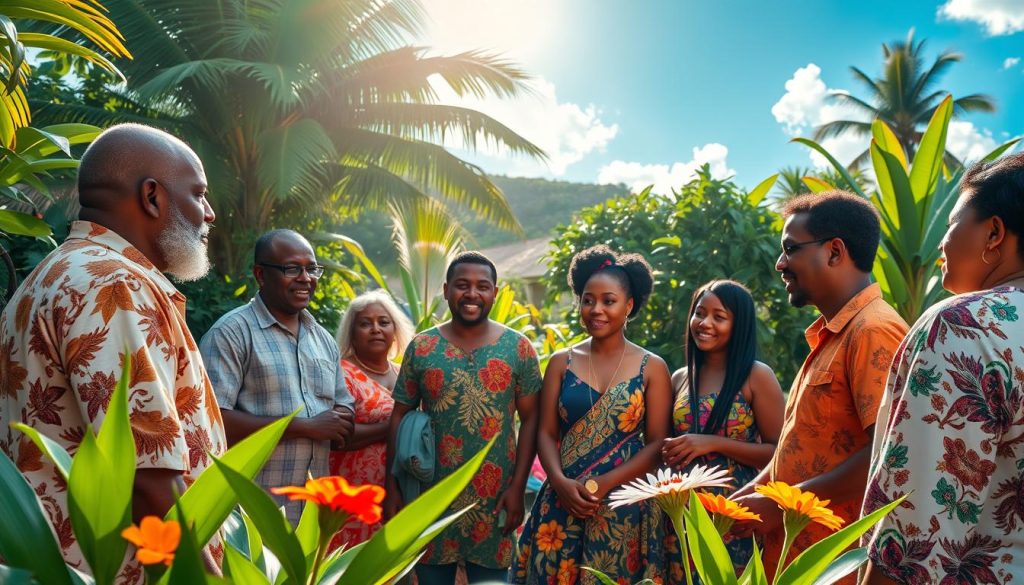
Comorian is deeply rooted in Africa’s rich linguistic history. It is closely related to Swahili. This language is more than just a way to talk; it’s a symbol of culture, social bonds, and history.
“Language is the road map of a culture. It tells you where its people come from and where they are going.” – Rita Mae Brown
Linguistic Characteristics of Shikomoro
- Bantu language family origin
- Closely related to Swahili
- Spoken by 96.9% of Comoros population
- Primary means of daily communication
The Comorian language shows the archipelago’s rich cultural mix. Dialects vary by island, each with its own stories and traditions.
| Language Aspect | Details |
|---|---|
| Language Family | Bantu |
| Speaker Percentage | 96.9% |
| Official Status | National Language |
| Linguistic Relatives | Swahili |
Learning Shikomoro is a way to see the strength of a language through history. It stands as a symbol of national pride and cultural heritage in the Comoros.
Dialects and Regional Variations of Comorian
The Comorian language is a rich tapestry of regional dialects. Each dialect reflects the unique cultural identity of its island home. These variations tell a story of geographical and historical diversity across the Comoros archipelago.
Comorian dialects form a fascinating linguistic landscape. Each island has its own distinct dialect. Despite their differences, speakers can understand each other about 80% of the time.
Shingazidja: The Grande Comore Dialect
Shingazidja is the most prominent Comorian dialect. It’s spoken by around 312,000 people on Grande Comore. This dialect is widely used, thanks to the island’s large population and cultural significance.
Shimwali: Language of Moheli
On Moheli, the Shimwali dialect thrives among 29,000 speakers. This dialect captures the intimate character of Moheli’s community. It preserves local linguistic traditions.
Shinzwani: Anjouan’s Linguistic Heritage
Shinzwani is the linguistic identity of Anjouan, spoken by about 275,000 people. This dialect showcases the island’s rich cultural nuances. It has subtle variations that distinguish it from other Comorian language forms.
| Dialect | Island | Number of Speakers |
|---|---|---|
| Shingazidja | Grande Comore | 312,000 |
| Shimwali | Moheli | 29,000 |
| Shinzwani | Anjouan | 275,000 |
These regional variations show the linguistic diversity of the Comoros. Each dialect has unique grammatical structures, pronunciation patterns, and local expressions. These reflect the islands’ distinct cultural identities.
French Language in Modern Comoros
Comoros, a Francophone nation, has a rich language history. French is key in government, education, and work across the islands.
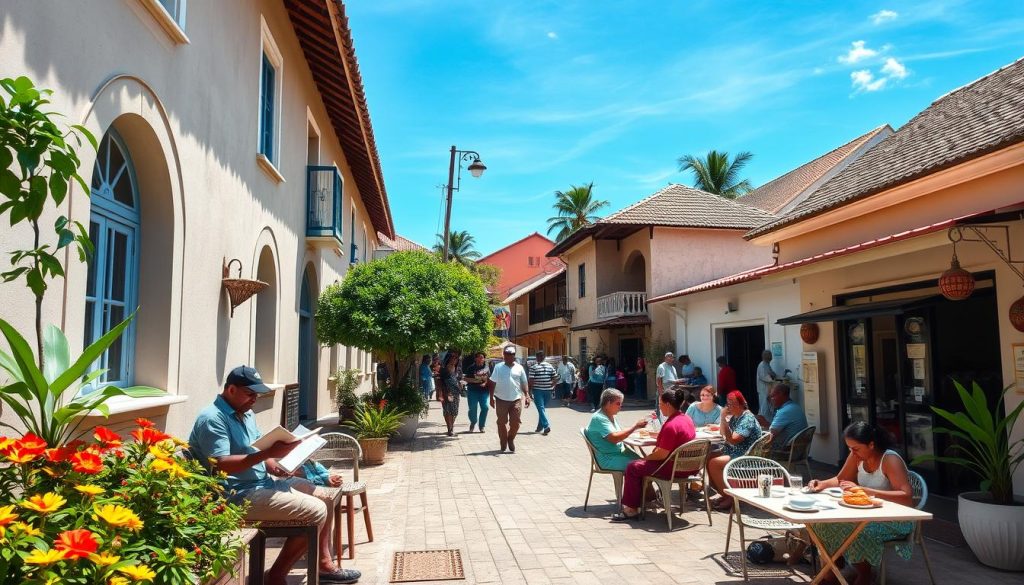
Learning about French in Comoros starts with some numbers. The Organisation Internationale de la Francophonie says about 25.97% of people speak French. This makes French a big part of the country’s language scene.
- Official language since colonial period (1841-1975)
- Used in government administration
- Primary language of commerce
- Essential for higher education
Knowing French opens doors for Comorians. It helps them talk to the world, learn more, and get better jobs. Students who speak French can find more chances in school and work, both at home and abroad.
“Language is the roadmap of a culture. It tells you where its people come from and where they are going.” – Rita Mae Brown
Even though it’s not spoken by most, French is very important in Comoros today. It works well with local languages like Comorian and Arabic. This shows the country’s rich mix of languages.
| Language | Percentage of Speakers | Primary Usage |
|---|---|---|
| Comorian | 96.9% | Daily communication |
| French | 25.97% | Government, commerce |
| Arabic | Majority | Religious, cultural contexts |
Getting to know French in Comoros means seeing its role as a link between local and global. For many, French is more than a language. It’s a way to new chances and understanding.
Arabic’s Religious and Cultural Significance
The Arabic language in Comoros is deeply connected to culture and religion. It goes beyond just talking. With 95% of people practicing Islam, Arabic is key to the islands’ identity.
Arabic is more than a prayer language in Comoros. Since the 1970s, it has become important in society too.
Evolution from Religious to Secular Usage
Arabic’s role in Comoros has changed over time. It started as a language for Islamic prayers. Now, it’s used in many areas of life:
- Educational curriculum integration
- International diplomatic communications
- Cultural preservation efforts
Arabic in Education and International Relations
Arabic is becoming more important in schools. Students see it as a way to:
- Improve global communication
- Understand different cultures
- Open up economic chances
Impact on Cultural Identity
For Comorians, Arabic is more than words. It connects them to their history and the Arab world.
“Language is the road map of a culture. It tells you where its people come from and where they are going.” – Rita Mae Brown
| Language Aspect | Cultural Significance |
|---|---|
| Religious Context | Primary liturgical language |
| Educational Role | Growing academic importance |
| International Communication | Connection to Arab diplomatic networks |
Seeing Arabic’s many roles helps us understand Comoros’ culture. Language is a bridge between old traditions and new ways.
Minority Languages and Their Communities
The language scene in Comoros is more than just its main languages. It’s a rich mix of minority languages that show the island’s cultural diversity. Malagasy and Swahili are key parts of this colorful language world.
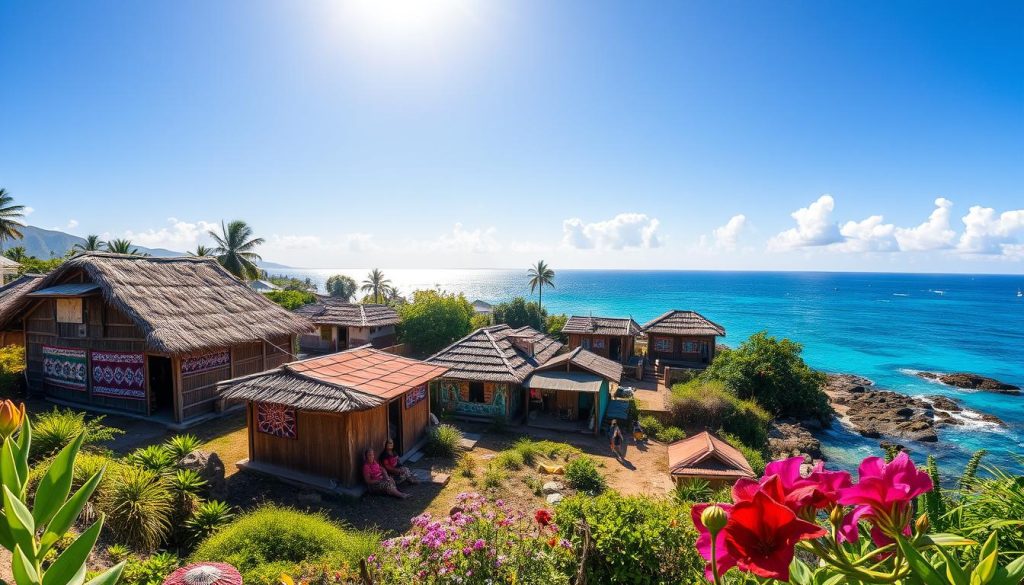
Shibushi, a special Malagasy dialect, adds a unique twist to Comoros’ language scene. With about 39,000 speakers, it shows how different cultures have mixed in the archipelago.
- Estimated Shibushi speakers: 39,000
- Linguistic origin: Malagasy dialect
- Geographic distribution: Scattered across Comoros Islands
Swahili is another interesting language in the area. Though only 1% speak it, it’s closely related to Comorian. This shows how languages in the Indian Ocean are connected.
“Languages are living bridges between cultures, connecting people beyond geographical boundaries.” – Language Diversity Research Institute
Minority languages like Shibushi and Swahili are key to Comoros’ rich cultural heritage. They keep alive special ways of talking that might otherwise fade away.
Learning about these languages helps us understand Comoros’ complex social world. Each language tells a story of history, trade, and cultural exchange that has made this island nation unique.
The Challenge of Written Comorian
The journey of written Comorian has been complex and fascinating. Language is more than words; it captures a culture’s soul. For Comorians, creating a standardized orthography is a key challenge that touches their national identity.
Historically, Comorian was written using the Ajami script, a variant of Arabic script. This script showed the deep Islamic cultural influences in the archipelago. After gaining independence in 1975, the Comorian government wanted a more accessible writing system.
Historical Writing Systems
The evolution of written Comorian involved many changes:
- Traditional Ajami script used for religious and informal writing
- Gradual introduction of Latin-based orthography
- Government-led standardization initiatives
Modern Standardization Efforts
Standardizing written Comorian has been tough. Experts, educators, and policymakers keep debating the best orthographic approach. The main goal is to create a writing system that is:
- Accessible to all Comorians
- Linguistically accurate
- Culturally representative
Current Orthographic Debates
Today, there are ongoing debates on the best way to write Comorian. An estimated one-third of the Comorian population cannot read or write in their native language. This shows how important it is to have a clear, standardized orthography.
“Language is the road map of a culture. It tells you where its people come from and where they are going.” – Rita Mae Brown
The search for a unified written Comorian is a deep journey of cultural preservation and linguistic identity.
Language in Education and Government
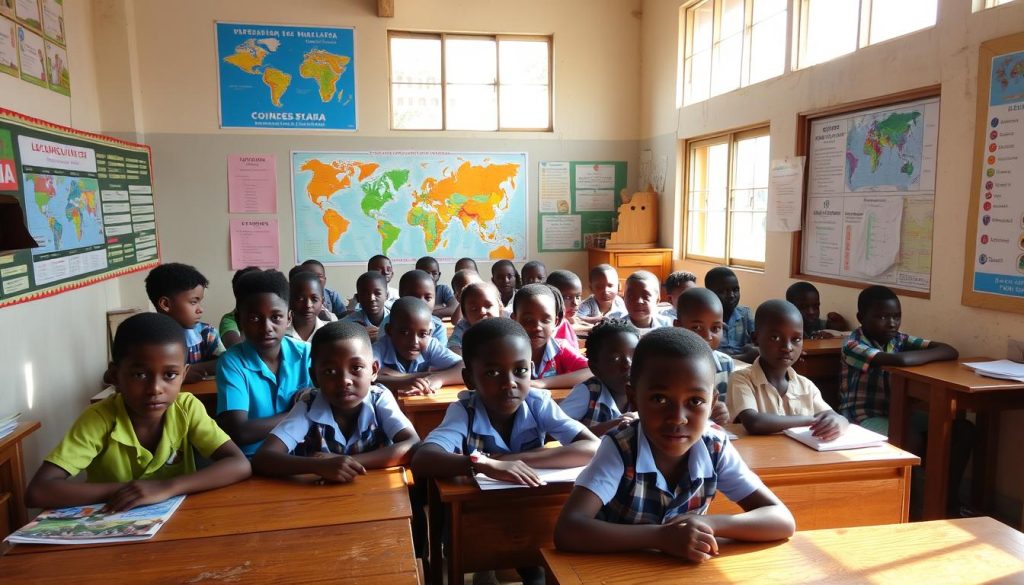
In the Comoros, language policy shapes education and government communication in unique ways. The country has three official languages: Comorian, French, and Arabic. This reflects its rich cultural heritage.
The education system mainly uses French, a legacy of colonial history. About 30% of the population speaks French. Arabic is important in religious and cultural contexts, with around 10% fluent.
- Comorian (Shikomoro) is spoken by 96.9% of the population
- French is the main language of formal education
- Arabic is used in cultural and religious education
Government communication faces a linguistic challenge. Official documents are in French, but local administration uses Comorian dialects. This shows the nation’s effort to balance official needs with cultural authenticity.
“Language is the road map of a culture. It tells you where its people come from and where they are going.” – Rita Mae Brown
Standardizing language use is a challenge in education and government. The government is working on policies that honor linguistic diversity while promoting unity.
The language policy in Comoros is a balance between history, culture, and modern needs. Education and government strategies are always evolving to meet these demands.
Language and Cultural Identity in Comoros
In the Comoros archipelago, language is a key part of cultural identity and history. The country’s many languages show a long history of trade, colonial rule, and cultural mixing.
Understanding Comorian language heritage means seeing how languages shape social life. Switching between Comorian, Arabic, and French is more than just talking. It shows the complexity of their culture.
“Language is the roadmap of a culture. It tells you where its people come from and where they are going.” – Rita Mae Brown
- Comorian is at the heart of national identity
- Arabic links people to their religious and historical past
- French helps connect them to the world
Young people in Comoros move easily between languages. They show a culture that values tradition and connects to the world today.
Keeping language diversity is key to keeping culture real in a world that’s getting more alike. Each language in Comoros tells stories, traditions, and memories that make the nation special.
Conclusion
Exploring Comoros languages shows the amazing diversity of this small island group. With about 19 languages spoken by 800,000 people, Comoros is a unique place. Here, Comorian, Arabic, French, and Malagasy languages blend together, creating a rich way of communicating.
The future of Comoros languages looks both promising and challenging. Younger people are learning French and Arabic, but there’s a push to keep native languages alive. This shows how language is more than just talking; it’s a key part of who we are.
Comoros is working hard to keep its languages safe. They want to make sure written Comorian is standard and protect all languages. As the world changes, Comoros is at a turning point. Their language scene is changing, showing the mix of cultures in the islands.
In the end, Comoros languages tell a story of strength, change, and cultural depth. This journey through their languages shows how they connect us, keep traditions alive, and help us deal with the world today.
The above is subject to change.
Check back often to TRAVEL.COM for the latest travel tips and deals.
Here are some Tours & Sightseeing suggestions that might pique your interests!
